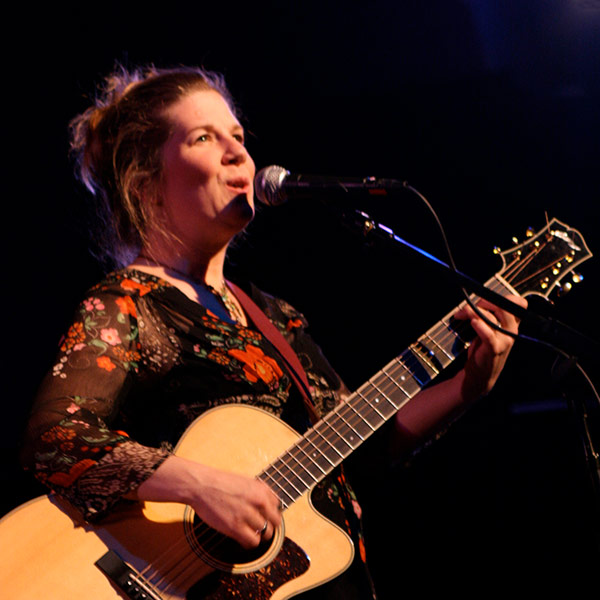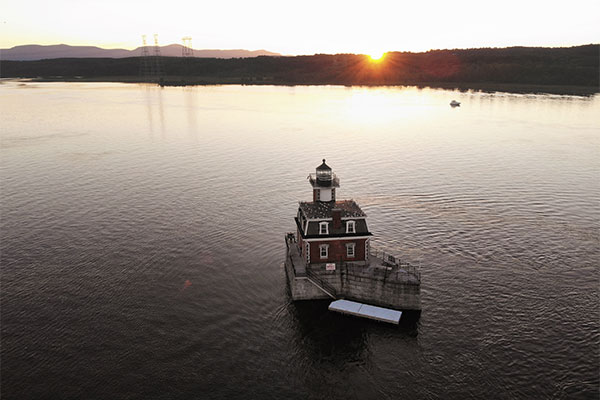Subtotal: $
Checkout
Dar Williams is a singer and songwriter whose more than twenty albums have sold millions of copies. Over a career spanning nearly thirty years, she has toured with Mary Chapin Carpenter, Patty Griffin, Ani DiFranco, The Nields, Shawn Colvin, Joan Baez, and many others. Hendrik Hertzberg of The New Yorker has described her as “one of America’s very best singer-songwriters.”
Here, she talks with Susannah Black of Plough Quarterly about her recent book What I Found in a Thousand Towns: A Traveling Musician’s Guide to Rebuilding America’s Communities – One Coffee Shop, Dog Run, and Open Mike Night at a Time (2017, Basic Books) and what it takes to create a place.
Plough: Even before you wrote What I Found in a Thousand Towns and started on this path as an accidental urbanist, many of your songs had always struck me as very conscious of place. Your book is inadvertent sociology, in a way – it reminds me of Jane Jacobs – but you’re primarily a musician. What was the process that led you to write the book?
Dar Williams: As I was touring with my music, I always had an eye out for good coffee, good food, for friendly and inspiring places. Often that would be in one neighborhood, an oasis within a town or city that was otherwise struggling, around the venue that I was playing. The next year, I’d come back and that neighborhood had grown.
What these places have in common is people who are able to help one another and to welcome outsiders. Solidarity combined with openness, hometown pride and worldly welcome. Everywhere I went, I’d look for that.
I was looking for something more than proximity: it was positive proximity. I became passionate about understanding what builds positive proximity. My observations blobbed themselves into three categories: first, certain kinds of spaces; second, identity-building projects; and third, what I call translation: how we translate ourselves and each other.
I gave a talk about this, mixed with my songs and, as I was doing that, I realized that the question of what creates that energy for us in places is all over my music. I started writing an article, and it became clear to me that it would be better as a book, because there were too many good examples, and too many ideas that towns and cities have come up with.

Dar Williams
The need for identity jumped out at me as something that your songs have dealt with: the line from “The Hudson”: “I thought I had no sense of place or past …”
I know! “Mortal City,” for example, is all about this as well, that cities thrive because people who like other people choose to live amongst other people. We go to these places so that we can be as smooshed together as possible. We want to collaborate. We want to rub two sticks together and see the fire. And that requires being around a lot of other people.
And right now there does seem to be both a communitarian left and a communitarian right forming in America, which are intersecting in interesting ways.
If you don’t have some communitarianism in your belief system, and you just think small government means you’ll have more freedom, you’ll find quickly that you’re governed by something else. If you don’t have the communitarian approach then everything will be sucked up by corporate interests: it will be monetized. Your wetlands that filter your water, and your zoning, and your quality of life will be capitalized on by corporate interests.
You can’t just be anti-government. Being anti-big government requires being pro-something else, or else you’re screwed. But government has to actually do a good job: to promote the thriving of those communities. I’ve seen a lot of cynicism about government in towns suffering because of bad urban planning.
What’s the balance between having that sense of rootedness and being open to newcomers?
This may sound too rosy, but I stand by it: positive proximity is both the builder of identity and the way of finding solutions to xenophobia and affordability issues. If a town has an affordable supermarket and an affordable drugstore and some kind of affordable housing and an ethos that respects a diversity of incomes, then it is actually possible to have it all, because the schools are going to be free; the quality of life will be free in a lot of ways – clean water and air, beauty. The things that we can all share as resources are for everybody.
Those towns also often take the next step, seek to plug the holes that are so deleterious to people with lower incomes or who are struggling with mental or physical illness. For instance, Beacon, New York, the nearest big town to me, was finding its grooviness, and it immediately built a community health center, and an addition to their library. Sure, some hipsters are gonna bump into you and not tell you sorry, because they’re rushing to the next cool thing on a Friday night. You’ll get some of that. But I’d rather have some of that hipster energy than nothing.
People started to say, “We are Beaconites. We’re not just from Beacon. We’re Beaconites. And Beaconites don’t want to see a guy talking to himself, sleeping on a park bench. We want that person to know that he’s a Beaconite. How are we going to embrace all those members of our community?” There are so many people who have been building that attitude. Rabbi Brent Spodek and his friend Ben do interfaith activities with different religious communities. And then there’s George: he worked construction and was also an artist, and he started a bar that catered to both those worlds. And Beacon had an amazing Republican-turned-independent mayor.
And then, of course, there’s Pete Seeger. Beacon was Pete’s home, and its identity is based partly in his legacy of community and folk music. When I started on the book, Pete was still alive and still working.
Beacon is pretty, and it’s got a lot of fancy stores, but they’re constantly looking for ways to avoid pure gentrification, to harmonize all these goods. Because they don’t want to just be any old town. When Pete died, everybody put picture of him, or of a banjo, in their store windows. They embraced that iconography of communitarianism.

The Hudson-Athens lighthouse on the Hudson River
And he worked hard to get them there. He worked to be persuasive; he was always spreading – I wouldn’t say gospel, but he was always spreading seeds. It was an ethos: You do it, Pete’s not gonna do it for you. But he didn’t just model how to live – he also told us: to stop being so acquisitive and to live with less, to be less obsessed with money and more interested in making music together. And now that’s in the streets of Beacon.
When I was first divorced and had moved into my new place, I was self-conscious about it. I thought it looked like grad student housing. And then I remembered Pete’s house. I’d gone over to his and Toshi’s place to learn a song. A woodsy property, and off to the side, stacked, old signs from protests against fracking and nuclear energy. Inside, there’s a wood stove, a rag rug, and spider plants – spider plants! I mean, how grad-student can you get? An old chair and an old couch. Pete showed me that that’s a fine way to be.
I once turned to a friend of mine and said, “That solo that Pete just did – I mean, this might sound irreverent, but that was sexy.” He was incredible. He could have been just a musician, but he set out to be a particular kind of neighbor, as well. And anything he asked me to do, I said yes, and I’m glad.
Can you talk about the importance of community and place for kids?
Both my kids walked to school every day and have friends in walking distance. We’d walk down to the river to watch movies by the river; we’d walk to the train to go to New York City. I’ve given them a beautiful, history-rich pedestrian town.
It’s a gift to give a child experiences that will echo and shimmer in their memory – the light over the mountain at twilight or the one tree outside their house that turns bright pink in April. When we give them that in childhood, they know to want it as adults. It’s a gift that’ll allow our civilization to flourish: that meaningful sense of interdependence, of belonging to a place.
Those little infinite moments – that’s what we can offer kids. That weird moment when the window is open and you’re seeing something, and you can’t describe what you’re seeing, it’s ineffable, but it’s a “this is what it’s all about” moment. It’s an infinite feeling.
And towns that have positive proximity are what foster that. You have to have a way of being in a place that’s not fear-based. That comes out of a sense of abundance, of seeing things happening generously around you.
“Southern California Wants to be Western New York” is obviously another place-based song. Can you talk about how you wrote it?
I was living in Ithaca, New York. So many of these houses had rust stains in the sink, little bottles that people had dug up outside in their yards lining the kitchen and bathroom windows –it was all a little creaky and old. But that’s what made it so special. I was there in the nineties, when they were just coming out of a pretty deep downturn. You felt the underdog quality, and you understood that you were there because you loved it, you were there to be invested in making it a better place.
And then I stayed with a friend in Pasadena who was longing for a place that allowed for that nostalgia that goes deeper than your own life. I can remember sitting and thinking, “Southern California wants to be Western New York.” And then I started to come up with examples of that Western New York flavor, that nice nuts-and-bolts creaky ghosty resonance. It’s the dorkiest song I’ve ever written, but I love when people are able to feel that sense of time. When people feel it they won’t automatically tear things down. I think we need to work out how not to tear things down.
How did you come to write “The Hudson”?
Chappaqua, New York, where I grew up, was really beautiful, there was a lot of nature, but we didn’t call it nature, we called it property. I was attached to the specific landscape – old walls, big trees, seasons, swamps, skating ponds and things. But I didn’t experience myself as very earthy-crunchy.
But in 1999 I was doing fundraisers from Troy, New York down through Brooklyn for Clearwater and the Hudson River Conservancy. And I found myself longing to return to the Hudson Valley. It held much more memory than I realized. The next year, I moved back, and never regretted it.
I always thought that Chappaqua was about good schools, a good gymnastics team, and a low-level, constant anxiety about your prospects and performance. But the crocuses and the wet bark in the spring, and the fireflies on summer nights – all of that made its way into me much deeper than I realized. I found myself writing a song trying to capture that moment when you realize that this landscape has made its way into you, and it is the glue of your life.

Sign up for the Plough Weekly email
Already a subscriber? Sign in
Try 3 months of unlimited access. Start your FREE TRIAL today. Cancel anytime.






